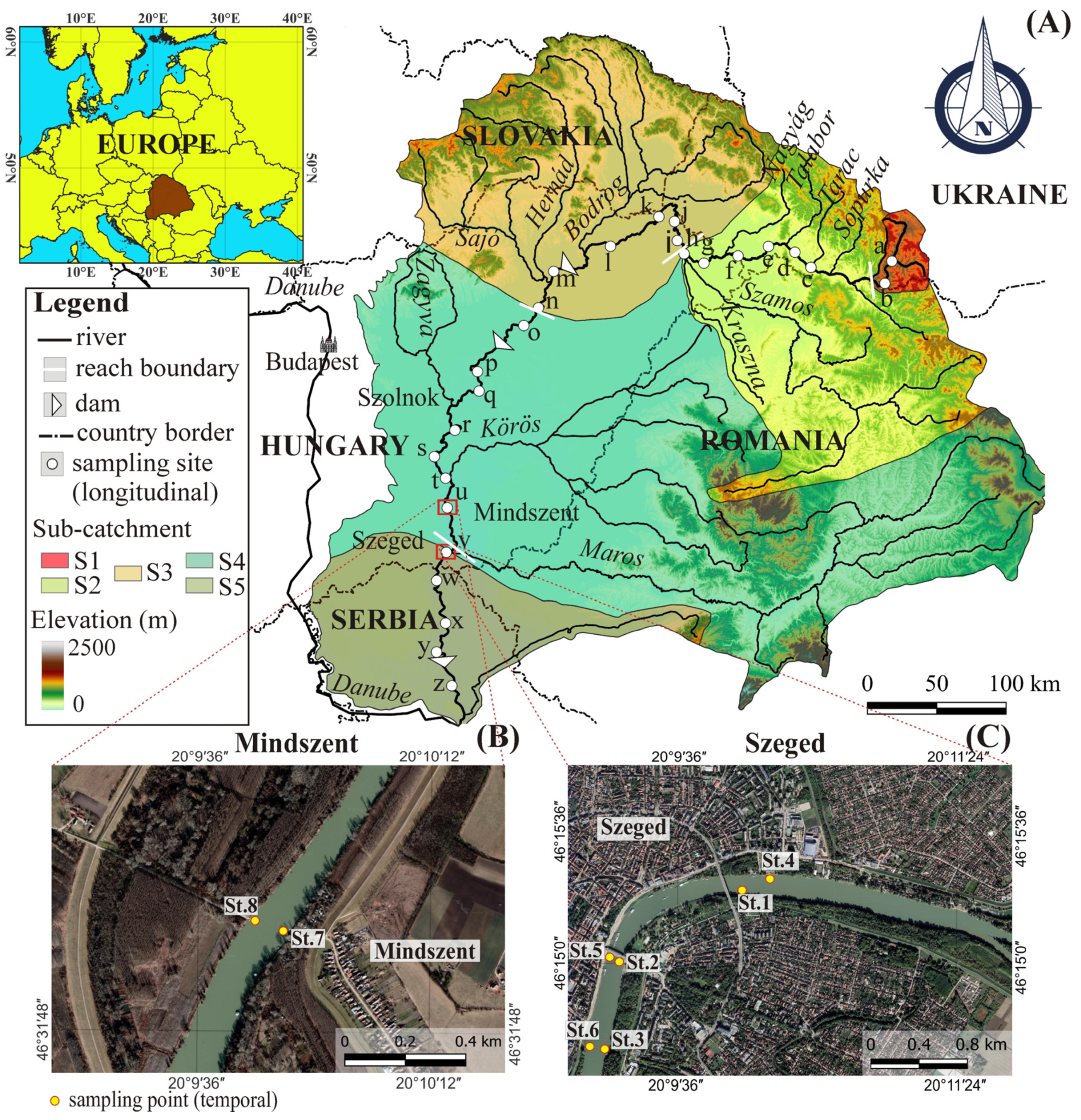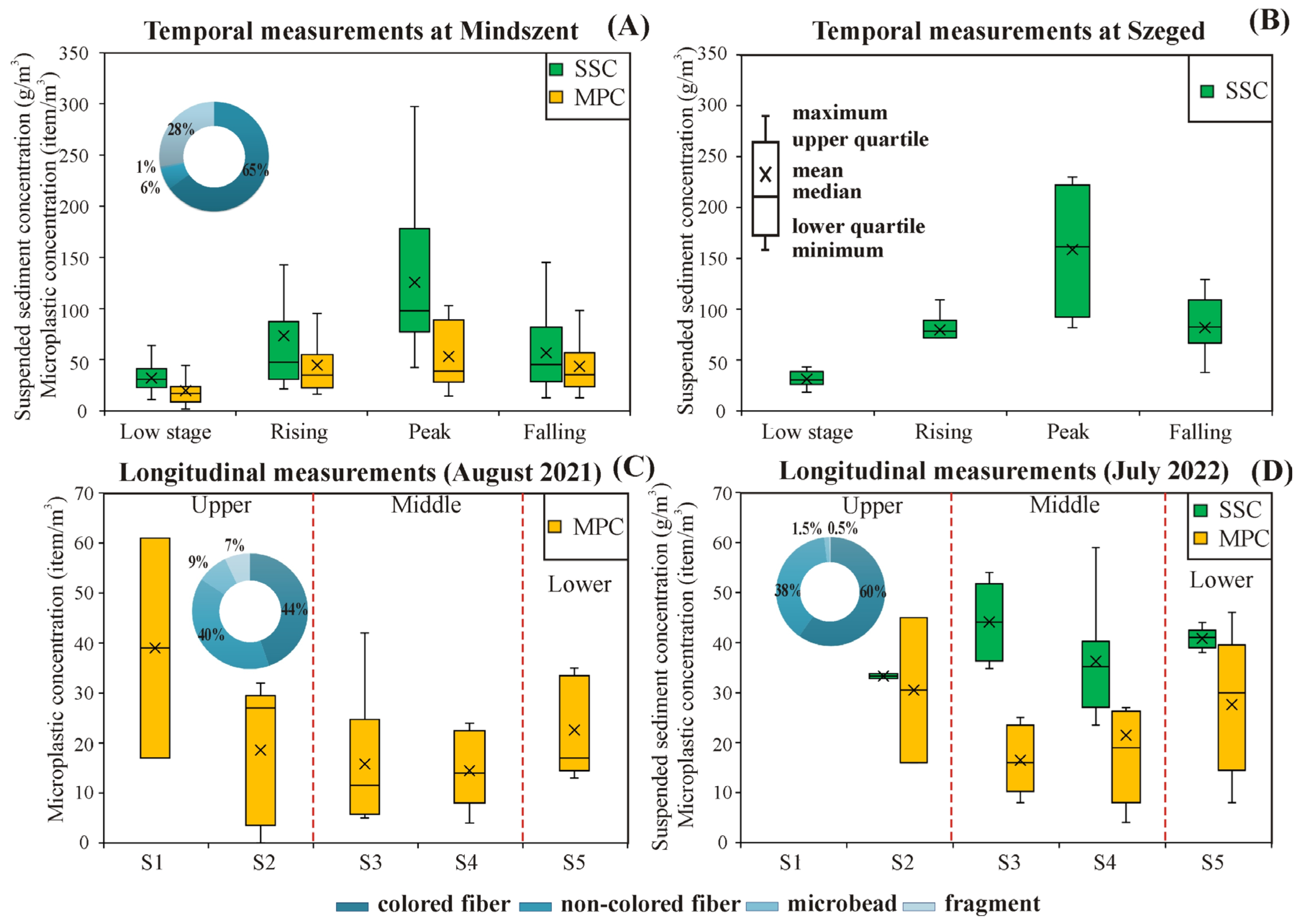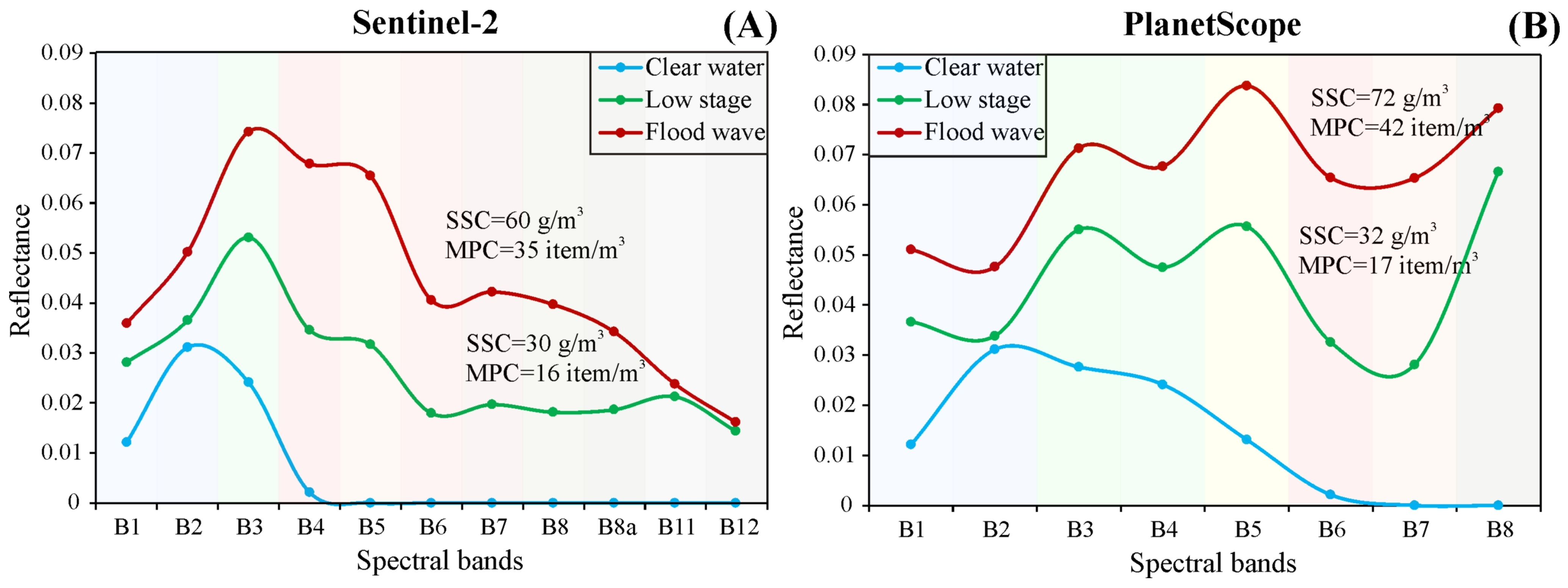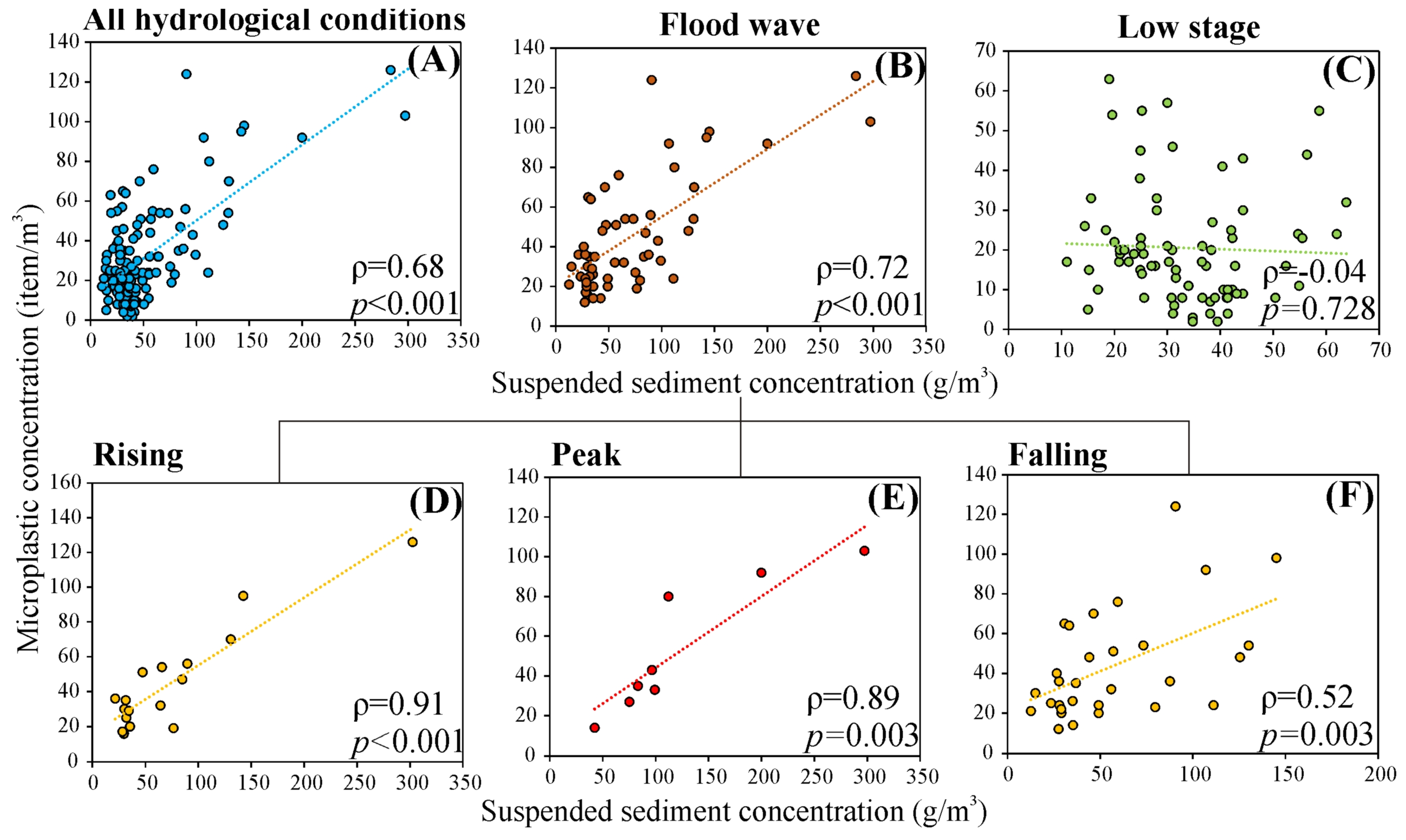Riverine Microplastic Quantification: A Novel Approach Integrating Satellite Images, Neural Network, and Suspended Sediment Data as a Proxy
Abstract
:1. Introduction
| Reference | Location | Satellite Sensor | Developed Model/ Type of Analysis | Application of a Proxy | Applicability of Satellite-Based MPC Estimation |
|---|---|---|---|---|---|
| Bentley [8] | Great Pacific Garbage Patch | MODIS Aqua | Reflectance model using 748 nm and 869 nm wavelengths | No | Yes |
| Hu [9] | Several marine environments | Sentinel-2 | Sensitivity and spectral analysis | No | Impossible |
| Davaasuren et al. [10] | North Pacific and North Atlantic Oceans | Sentinel-1A and COSMO-SkyMed | Detecting the influence of surfactant (related to MPC) on wind-driven surface roughness | Surfactants and bio-film | Probably by SAR images |
| Evans and Ruf [11] | CYGNSS bistatic radars | Empirical model based on surfactant (related to MPC) influence on wind-driven surface roughness | Yes | ||
| Piehl et al. [16] | Trave, Elbe, and Po Rivers | Landsat 8 | Empirical models between MPC and active water constituents | Colored dissolved organic matter, chlorophyll-a, and SSC | Probably |
| Atwood et al. [2] | Po River | Remote sensing-based SSC model as a proxy for MPC | SSC | Yes (with some limitations) |
2. Materials and Methods
2.1. Study Area
2.2. In Situ Measurements
2.3. Laboratory Analysis
2.4. Remote Sensing Data
2.4.1. Passive Sensors
2.4.2. Active Sensor
2.5. Pre-Processing of Remote Sensing Data
2.5.1. Passive Sensors
2.5.2. Active Sensor
2.6. Correlation Analysis
2.7. Remote Sensing of Suspended Sediment (SS) and Microplastic (MP) Concentrations
2.8. Suspended Sediment Concentration as a Proxy for Microplastics
3. Results
3.1. Spatiotemporal Distribution of Suspended Sediment (SS) and Microplastic (MP) Concentrations in the Tisza River
3.2. Correlation and Spectral Signature
3.3. Suspended Sediment and Microplastic Concentration Models
3.3.1. Remote Sensing-Based Models
3.3.2. Contribution of Bands in the Developed Models
3.3.3. Suspended Sediment-Based Models for Microplastic Concentration
3.4. Spatiotemporal Generalization Capability of the Developed Models
4. Discussion
4.1. Suspended Sediment (SS) and Microplastic (MP) Concentration Patterns in the Tisza River
4.2. Efficiency of Satellite Sensors for Direct Estimation of Suspended Sediment and Microplastic Concentrations
4.2.1. Evaluation of Passive Sensors
4.2.2. Evaluation of Active Sensor
4.3. Applicability of Neural Network Algorithm for Developing Microplastic and Suspended Sediment Concentration Models
4.4. Evaluation of Indirect Estimation of Microplastic by a Proxy: Advantages and Limitations
4.5. Implications of the Developed Microplastic Models and Future Research
5. Conclusions
Author Contributions
Funding
Institutional Review Board Statement
Informed Consent Statement
Data Availability Statement
Acknowledgments
Conflicts of Interest
Appendix A
| Tisza Reach | Upper | Middle | Lower | ||
|---|---|---|---|---|---|
| Section | S1 | S2 | S3 | S4 | S5 |
| Slope (cm/km) | 2000–5000 | 110–13 | ≥ 3 | 1–3 | <2.5 |
| Flow velocity (m/s) | 2–3 | 1 | 0.1–0.5 | 0.1–0.2 | <0.2 |
| Mean discharge (m3/s) | 22 | 207 | 346 | 509 | 864 |
| Bed load (m3/year) | No data | 22.6 × 103 | 8.8 × 103 | 11 × 103 | 9 × 103 |
| Suspended load (m3/year) | No data | 0.9 × 106 | 5 × 106 | 12.2 × 106 | 12.9 × 106 |
| Mean SSC (g/m3) | No data | 74 | 85 | 97 | 384 |
| Mean MPC in the water (item/m3) (during a low stage) | 39 ± 31.1 | 18.6 ± 14.2 | 15.8 ± 13.8 | 14.5 ± 7.9 | 22.6 ± 10.1 |
| Mean MPC in the sediment (item/dry kg) (during a low stage) | 978 ± 817 | 1625 ± 1223 | 2082 ± 1511 | 2019 ± 1305 | 530 ± 169 |
| Spectral Band | Sentinel-2 | PlanetScope | ||||
|---|---|---|---|---|---|---|
| Central Wavelength (nm) | Spatial Resolution (m) | Bandwidth (nm) | Central Wavelength (nm) | Spatial Resolution (m) | Bandwidth (nm) | |
| B1 | 443 a | 60 | 20 | 443 a | 3 | 21 |
| B2 | 492 b | 10 | 65 | 490 b | 3 | 50 |
| B3 | 560 c | 10 | 35 | 531 | 3 | 36 |
| B4 | 665 d | 10 | 30 | 565 c | 3 | 36 |
| B5 | 704 e | 20 | 15 | 610 | 3 | 20 |
| B6 | 741 | 20 | 15 | 665 d | 3 | 30 |
| B7 | 783 | 20 | 20 | 705 e | 3 | 16 |
| B8 | 833 | 10 | 115 | 865 f | 3 | 40 |
| B8a | 865f | 20 | 20 | – | – | |
| B9 | 945 | 60 | 20 | – | – | |
| B10 | 1374 | 60 | 30 | – | – | |
| B11 | 1614 | 20 | 90 | – | – | |
| B12 | 2202 | 20 | 180 | – | – | |


References
- Mukonza, S.S.; Chiang, J.-L. Satellite sensors as an emerging technique for monitoring macro- and microplastics in aquatic ecosystems. Water Emerg. Contam. Nanoplastics 2022, 1, 17. [Google Scholar] [CrossRef]
- Atwood, E.C.; Falcieri, F.M.; Piehl, S.; Bochow, M.; Matthies, M.; Franke, J.; Carniel, S.; Sclavo, M.; Laforsch, C.; Siegert, F. Coastal accumulation of microplastic particles emitted from the Po River, Northern Italy: Comparing remote sensing and hydrodynamic modelling with in situ sample collections. Mar. Pollut. Bull. 2019, 138, 561–574. [Google Scholar] [CrossRef] [PubMed]
- Schrank, I.; Löder, M.G.J.; Imhof, H.K.; Moses, S.R.; Heß, M.; Schwaiger, J.; Laforsch, C. Riverine microplastic contamination in southwest Germany: A large-scale survey. Front. Earth Sci. 2022, 10, 794250. [Google Scholar] [CrossRef]
- Balla, A.; Mohsen, A.; Gönczy, S.; Kiss, T. Spatial variations in microfiber transport in a transnational river basin. Appl. Sci. 2022, 12, 10852. [Google Scholar] [CrossRef]
- Pilechi, A.; Mohammadian, A.; Murphy, E. A numerical framework for modeling fate and transport of microplastics in inland and coastal waters. Mar. Pollut. Bull. 2022, 184, 114119. [Google Scholar] [CrossRef]
- Whitehead, P.G.; Bussi, G.; Hughes, J.M.R.; Castro-Castellon, A.T.; Norling, M.D.; Jeffers, E.S.; Rampley, C.P.N.; Read, D.S.; Horton, A.A. Modelling microplastics in the River Thames: Sources, sinks and policy implications. Water 2021, 13, 861. [Google Scholar] [CrossRef]
- Mohsen, A.; Kovács, F.; Kiss, T. Remote sensing of sediment discharge in rivers using Sentinel-2 images and machine-learning algorithms. Hydrology 2022, 9, 88. [Google Scholar] [CrossRef]
- Bentley, J. Detecting Ocean Microplastics with Remote Sensing in the Near-Infrared: A Feasibility Study. Ph.D. Thesis, Bridgewater State University, Bridgewater, MA, USA, 2019. [Google Scholar]
- Hu, C. Remote detection of marine debris using satellite observations in the visible and near infrared spectral range: Challenges and potentials. Remote Sens. Environ. 2021, 259, 112414. [Google Scholar] [CrossRef]
- Davaasuren, N.; Marino, A.; Boardman, C.; Alparone, M.; Nunziata, F.; Ackermann, N.; Hajnsek, I. Detecting microplastics pollution in world oceans using SAR remote sensing. In Proceedings of the IGARSS 2018-2018 IEEE International Geoscience and Remote Sensing Symposium, Valencia, Spain, 22–27 July 2018; pp. 938–941. [Google Scholar]
- Evans, M.C.; Ruf, C.S. Toward the detection and imaging of ocean microplastics with a spaceborne radar. IEEE Trans. Geosci. Remote Sens. 2022, 60, 1–9. [Google Scholar] [CrossRef]
- Martin, J.L.; McCutcheon, S.C. Hydrodynamics and Transport for Water Quality Modeling; CRC Press: Boca Raton, FL, USA, 1998. [Google Scholar]
- He, G.; Hermanto, M.W.; Tjahjono, M.; Chow, P.S.; Tan, R.B.H.; Garland, M. Comparison of dielectric constant meter with turbidity meter and focused beam reflectance measurement for metastable zone width determination. Chem. Eng. Res. Des. 2012, 90, 259–265. [Google Scholar] [CrossRef]
- Simpson, M.D.; Marino, A.; de Maagt, P.; Gandini, E.; Hunter, P.; Spyrakos, E.; Tyler, A.; Telfer, T. Monitoring of plastic islands in river environment using sentinel-1 SAR data. Remote Sens. 2022, 14, 4473. [Google Scholar] [CrossRef]
- Chen, H.L.; Gibbins, C.N.; Selvam, S.B.; Ting, K.N. Spatio-temporal variation of microplastic along a rural to urban transition in a tropical river. Environ. Pollut. 2021, 289, 117895. [Google Scholar] [CrossRef] [PubMed]
- Piehl, S.; Atwood, E.C.; Bochow, M.; Imhof, H.K.; Franke, J.; Siegert, F.; Laforsch, C. Can water constituents be used as proxy to map microplastic dispersal within transitional and coastal waters? Front. Environ. Sci. 2020, 8, 92. [Google Scholar] [CrossRef]
- Mercedes, M.; Esther, G.; Francesc, P.; Jordi, C. Drifting plastic debris as a potential vector for dispersing Harmful Algal Bloom (HAB) species. Sci. Mar. 2003, 67, 107–111. [Google Scholar] [CrossRef]
- Waldschläger, K.; Brückner, M.Z.M.; Carney Almroth, B.; Hackney, C.R.; Adyel, T.M.; Alimi, O.S.; Belontz, S.L.; Cowger, W.; Doyle, D.; Gray, A.; et al. Learning from natural sediments to tackle microplastics challenges: A multidisciplinary perspective. Earth-Sci. Rev. 2022, 228, 104021. [Google Scholar] [CrossRef]
- Lászlóffy, W. A Tisza—Vízi Munkálatok és Vízgazdálkodás Tiszai Vízrendszerben (The Tisza River: Water Development and Management in its River Basin); Akadémiai Kiadó: Budapest, Hungary, 1982. [Google Scholar]
- ICPDR. Analysis of the Tisza River Basin 2007; International Commission for the Protection of the Danube River, Vienna International Centre/D0412: Vienna, Austria, 2007; p. 136. [Google Scholar]
- Kiss, T.; Fórián, S.; Szatmári, G.; Sipos, G. Spatial distribution of microplastics in the fluvial sediments of a transboundary river–A case study of the Tisza River in Central Europe. Sci. Total Environ. 2021, 785, 147306. [Google Scholar] [CrossRef]
- Eurostat. Municipal Waste Statistics. Available online: https://ec.europa.eu/eurostat/statistics-explained/index.php?title=Municipal_waste_statistics (accessed on 1 October 2023).
- Interreg. Report on Significant Pressures Relevant for the Tisza River Basin. Deliverable 3.2.1 Report on Significant Pressures Relevant for the TRB; Danube Transnational Programme: Budapest, Hungary, 2018. [Google Scholar]
- Amissah, J.; Kiss, T.; Fiala, K. Morphological evolution of the lower Tisza River (Hungary) in the 20th century in response to human interventions. Water 2018, 10, 884. [Google Scholar] [CrossRef]
- Mohsen, A.; Kovács, F.; Mezősi, G.; Kiss, T. Sediment transport dynamism in the confluence area of two rivers transporting mainly suspended sediment based on Sentinel-2 satellite images. Water 2021, 13, 3132. [Google Scholar] [CrossRef]
- Guy, H.P. Laboratory theory and methods for sediment analysis. In Techniques of Water-Resources Investigations; U.S. Geological Survey, Techniques of Water-Resources Investigations, Book 5; USGS: Reston, VA, USA, 1969. [Google Scholar] [CrossRef]
- ASTM D3977-97R07; Standard Test Method for Determining Sediment Concentration in Water Samples. ASTM: West Conshohocken, PA, USA, 2007. [CrossRef]
- Xiao, S.; Cui, Y.; Brahney, J.; Mahowald, N.M.; Li, Q. Long-distance atmospheric transport of microplastic fibres influenced by their shapes. Nat. Geosci. 2023, 16, 863–870. [Google Scholar] [CrossRef]
- Tan, B.; Wolfe, R.; Lin, G. PlanetScope imagery geolocation accuracy assessment. In Proceedings of the AGU Fall Meeting, New Orleans, LA, USA, 13–17 December 2021; p. B15I-1545. [Google Scholar]
- McFeeters, S.K. The use of the Normalized Difference Water Index (NDWI) in the delineation of open water features. Int. J. Remote Sens. 1996, 17, 1425–1432. [Google Scholar] [CrossRef]
- Otsu, N. A threshold selection method from gray-level histograms. IEEE Trans. Syst. Man Cybern. 1979, 9, 62–66. [Google Scholar] [CrossRef]
- Shao, W.; Zhao, C.; Jiang, X.; Sun, Z.; Wang, X.; Wang, J.; Cai, L. Characteristics of suspended sediment in Sentinel-1 synthetic aperture radar observations. Remote Sens. Lett. 2021, 12, 1167–1179. [Google Scholar] [CrossRef]
- Youshen, X. A new neural network for solving linear and quadratic programming problems. IEEE Trans. Neural Netw. 1996, 7, 1544–1548. [Google Scholar] [CrossRef] [PubMed]
- Abriha, D.; Szabó, S. Strategies in training deep learning models to extract building from multisource images with small training sample sizes. Int. J. Digit. Earth 2023, 16, 1707–1724. [Google Scholar] [CrossRef]
- Glinka, S.; Bajer, J.; Wierzbicki, D.; Karwowska, K.; Kedzierski, M. The Use of Deep Learning Methods for Object Height Estimation in High Resolution Satellite Images. Sensors 2023, 23, 8162. [Google Scholar] [CrossRef] [PubMed]
- Optuna. Available online: https://optuna.org/ (accessed on 1 October 2023).
- Lundberg, S.M.; Lee, S.-I. A unified approach to interpreting model predictions. Adv. Neural Inf. Process. Syst. 2017, 30, 4766. [Google Scholar]
- Laermanns, H.; Reifferscheid, G.; Kruse, J.; Földi, C.; Dierkes, G.; Schaefer, D.; Scherer, C.; Bogner, C.; Stock, F. Microplastic in water and sediments at the confluence of the Elbe and Mulde Rivers in Germany. Front. Environ. Sci. 2021, 9, 794895. [Google Scholar] [CrossRef]
- Béjar, M.; Vericat, D.; Batalla, R.J.; Gibbins, C.N. Variation in flow and suspended sediment transport in a montane river affected by hydropeaking and instream mining. Geomorphology 2018, 310, 69–83. [Google Scholar] [CrossRef]
- Rodrigues, S.M.; Almeida, C.M.R.; Silva, D.; Cunha, J.; Antunes, C.; Freitas, V.; Ramos, S. Microplastic contamination in an urban estuary: Abundance and distribution of microplastics and fish larvae in the Douro estuary. Sci. Total Environ. 2019, 659, 1071–1081. [Google Scholar] [CrossRef]
- Sébastien, S.; Pauline, C. Technical Note on Quality Assessment for superDove. Available online: https://earth.esa.int/eogateway/documents/20142/37627/Technical%20Note%20on%20Quality%20Assessment%20for%20PlanetScope%20%28SuperDOVE%29 (accessed on 1 October 2023).
- Umar, M.; Rhoads, B.L.; Greenberg, J. Use of multispectral satellite remote sensing to assess mixing of suspended sediment downstream of large river confluences. J. Hydrol. 2018, 556, 325–338. [Google Scholar] [CrossRef]
- Liu, Y.-M.; Zhang, L.; Zhou, M.; Liang, J.; Wang, Y.; Sun, L.; Li, Q.-L. A neural networks based method for suspended sediment concentration retrieval from GF-5 hyperspectral images. J. Infrared Millim. Waves 2022, 41. [Google Scholar] [CrossRef]
- Larson, M.D.; Simic Milas, A.; Vincent, R.K.; Evans, J.E. Multi-depth suspended sediment estimation using high-resolution remote-sensing UAV in Maumee River, Ohio. Int. J. Remote Sens. 2018, 39, 5472–5489. [Google Scholar] [CrossRef]
- Pereira, F.J.S.; Costa, C.A.G.; Foerster, S.; Brosinsky, A.; de Araújo, J.C. Estimation of suspended sediment concentration in an intermittent river using multi-temporal high-resolution satellite imagery. Int. J. Appl. Earth Obs. Geoinf. 2019, 79, 153–161. [Google Scholar] [CrossRef]
- Mohsen, A.; Balla, A.; Kiss, T. High spatiotemporal resolution analysis on suspended sediment and microplastic transport of a lowland river. Sci. Total Environ. 2023, 902, 166188. [Google Scholar] [CrossRef] [PubMed]









| Model | Hyperparameters | |||||||
|---|---|---|---|---|---|---|---|---|
| Hidden Layer Sizes | Activation Function | Solver | Alpha | Learning Rate | Maximum Iteration | Batch Size | ||
| SSC | Sentinel-2 | (100, 5, 20) | logistic | lbfgs | 0.0003 | invscaling | 604 | 67 |
| PlanetScope | (40, 10, 20) | relu | lbfgs | 0.0239 | constant | 669 | 120 | |
| Sentinel-1 | (50, 50) | tanh | adam | 0.0001 | constant | 521 | 44 | |
| MPC | Sentinel-2 | (100) | relu | adam | 0.0191 | invscaling | 985 | 33 |
| PlanetScope | (150, 150) | tanh | adam | 0.0001 | adaptive | 865 | 121 | |
| Sentinel-1 | (10, 15) | relu | sgd | 0.0011 | adaptive | 748 | 116 | |
| Hydrological Condition | Regression Model | R2 | RMSE (Item/m3) | MAE (Item/m3) |
|---|---|---|---|---|
| All hydrological conditions | MPC =−0.0004 SSC2 + 0.499 SSC + 8.790 | 0.51 | 17.9 | 13.7 |
| Low stage | MPC = 0.001 SSC3 − 0.093 SSC2 + 2.193 SSC + 6.902 | 0.17 | 12.9 | 9.4 |
| Rising limb | MPC = 0.391 SSC + 15.942 | 0.83 | 11.8 | 9.5 |
| Peak | MPC = −0.0017 SSC2 + 0.954 SSC-29.445 | 0.88 | 7.76 | 10.76 |
| Falling limb | MPC = 6 × 10−5 SSC3 − 0.014 SSC2 + 1.425 SSC + 2.278 | 0.28 | 22.8 | 18.18 |
Disclaimer/Publisher’s Note: The statements, opinions and data contained in all publications are solely those of the individual author(s) and contributor(s) and not of MDPI and/or the editor(s). MDPI and/or the editor(s) disclaim responsibility for any injury to people or property resulting from any ideas, methods, instructions or products referred to in the content. |
© 2023 by the authors. Licensee MDPI, Basel, Switzerland. This article is an open access article distributed under the terms and conditions of the Creative Commons Attribution (CC BY) license (https://creativecommons.org/licenses/by/4.0/).
Share and Cite
Mohsen, A.; Kovács, F.; Kiss, T. Riverine Microplastic Quantification: A Novel Approach Integrating Satellite Images, Neural Network, and Suspended Sediment Data as a Proxy. Sensors 2023, 23, 9505. https://doi.org/10.3390/s23239505
Mohsen A, Kovács F, Kiss T. Riverine Microplastic Quantification: A Novel Approach Integrating Satellite Images, Neural Network, and Suspended Sediment Data as a Proxy. Sensors. 2023; 23(23):9505. https://doi.org/10.3390/s23239505
Chicago/Turabian StyleMohsen, Ahmed, Ferenc Kovács, and Tímea Kiss. 2023. "Riverine Microplastic Quantification: A Novel Approach Integrating Satellite Images, Neural Network, and Suspended Sediment Data as a Proxy" Sensors 23, no. 23: 9505. https://doi.org/10.3390/s23239505
APA StyleMohsen, A., Kovács, F., & Kiss, T. (2023). Riverine Microplastic Quantification: A Novel Approach Integrating Satellite Images, Neural Network, and Suspended Sediment Data as a Proxy. Sensors, 23(23), 9505. https://doi.org/10.3390/s23239505






